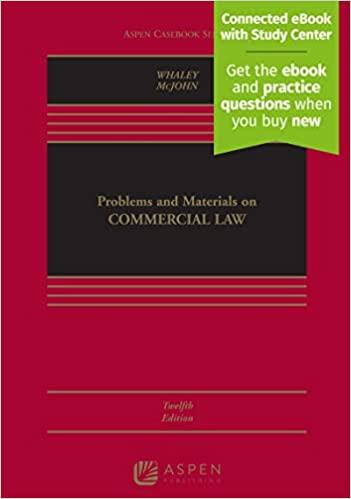Question
Cases 1. 3D Printing: Will Additive Manufacturing Solve the Bullwhip Effect? * Precision Parts (PP) was a traditional machine shop producing OEM parts for the
Cases
- 1.
3D Printing: Will Additive Manufacturing Solve the Bullwhip Effect? *
Precision Parts (PP) was a traditional machine shop producing OEM parts for the construction equipment industry until 2017 when they began a transition to an additive manufacturer using state-of-the-art 3D printing. Early last year, two of Precision Parts' customers representing 35 percent of their revenue and 47 percent of their profit notified PP that orders for their industrial grade fasteners would be reduced by almost 75 percent. Both manufacturing companies explained a shift in their supplier pool as part of the reevaluation of parts supplier-partners in their second-tier integration efforts. Fortunately, the industrial fastener sales team had been working with Crane-Tech Manufacturing (C-TM) to include Precision Parts as one of their primary parts suppliers. Crane-Tech Manufacturing uses industrial fasteners for their OEM processes (crane equipment used in the construction industry) and for the aftermarket parts used for repair and replacement. The contract would triple orders and make up about 90 percent of the lost revenue. The contract was contingent on Precision Parts addressing the following requirements: collaborate in cost reduction practices in parts, inventory, and transportation; maintain adequate inventory of OEM parts and aftermarket parts for equipment sold in past 20 years; be responsive to on-demand order batches; and reduce lead times for parts.
In 2016, Precision Parts invested in three HP multijet fusion 4200 3D printers averaging $200,000 per printer. Each printer could produce the entire Precision Parts fastener line using digital designs and plastic materials. PP's R&D will field test and approve products for all required product specifications starting with products that Crane-Tech Manufacturing purchases. Precision Parts will be locating the three HP 3D printers in strategic decentralized locations in proximity to the three largest C-TM manufacturing facilities.
3D printing is an additive manufacturing process that produces three-dimensional objects from a digital file. A 3D printed item is manufactured by laying down successive layers of materials until the computer-generated designed product is produced. Materials used in 3D printing are much more diverse than metal machining and includes metals (aluminum, gold, silver, steel, etc.), ceramics, porcelain, plastic, acrylics, sandstone, and many other materials. 3D printing uses less material inputs and reduces material waste. 3D printed products can also use alternative materials and designs (i.e., honeycomb) that reduce weight and raw material costs. 3D printing can redesign parts to consolidate part and subassembly components. 3D printing design capability eliminates the need to develop and produce tooling required in more traditional machining operations. 3D printing's digital design and single-piece efficiencies are not negatively cost impacted at low production volumes. Lead times for low-volume 3D parts are significantly less than traditional machined parts with the quick cycle time from design to produced part. Make-to-order parts with quick changeovers will reduce labor costs and storage and handling as WIP and finished goods inventories become unnecessary. Waste at any time in the process can be recycled when 3D printing uses heat-processed recyclable plastics.
Crane-Tech Manufacturing invited Precision Parts to submit a bid to be approved in their Elite Supplier Program. Precision Parts' bid would focus on the key advantages to C-TM if they contracted with an additive manufacturer. PP would produce make-to-order parts that can be ordered, designed, produced, and shipped within three days and delivered next day if the digital design file is submitted with the order. Precision Parts will commit to a lead time of one-day production plus one-day delivery when an order from Crane-Tech Manufacturing is placed with notification dates ten days, three days, and one day before the parts need to be delivered to a C-TM facility. Industry lead-time standards are four weeks for CNC machined parts. Precision Parts' make-to-order capability will enable PP to produce newly designed parts for new equipment models. PP's additive manufacturing can produce parts for discontinued equipment (old models) as needed, rather than storing these in inventory. This feature will reduce the risk of obsolescence and replace the need to maintain adequate inventories for old equipment. Precision Parts' 3D printed parts can be used in prototypes and collaborative R&D with Crane-Tech Manufacturing, replacements for broken or worn machine parts, and as needed for production runs by C-TM's OEM facilities.
Discussion Questions
1. What are the challenges and benefits for Crane-Tech Manufacturing if they use Precision Parts' 3D printing capability to improve production of equipment and aftermarket parts orders for its customers?
2. How much warehouse space expansion should C-TM add to include the new 3D printed parts used for aftermarket sales?
3. Will the supply chain partnership with Precision Parts improve Crane-Tech Manufacturing's sustainable competitive advantage in the construction equipment and aftermarket parts industries?
Step by Step Solution
There are 3 Steps involved in it
Step: 1

Get Instant Access to Expert-Tailored Solutions
See step-by-step solutions with expert insights and AI powered tools for academic success
Step: 2

Step: 3

Ace Your Homework with AI
Get the answers you need in no time with our AI-driven, step-by-step assistance
Get Started


